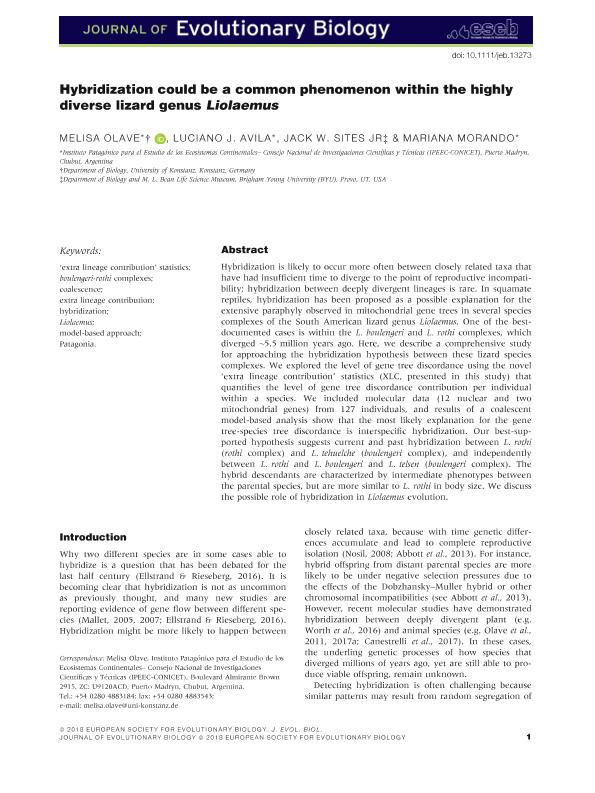Mostrar el registro sencillo del ítem
dc.contributor.author
Olave, Melisa

dc.contributor.author
Avila, Luciano Javier

dc.contributor.author
Sites, Jack W.
dc.contributor.author
Morando, Mariana

dc.date.available
2019-11-07T21:24:22Z
dc.date.issued
2018-06
dc.identifier.citation
Olave, Melisa; Avila, Luciano Javier; Sites, Jack W.; Morando, Mariana; Hybridization could be a common phenomenon within the highly diverse lizard genus Liolaemus; Wiley Blackwell Publishing, Inc; Journal of Evolutionary Biology; 31; 6; 6-2018; 893-903
dc.identifier.issn
1010-061X
dc.identifier.uri
http://hdl.handle.net/11336/88258
dc.description.abstract
Hybridization is likely to occur more often between closely related taxa that have had insufficient time to diverge to the point of reproductive incompatibility; hybridization between deeply divergent lineages is rare. In squamate reptiles, hybridization has been proposed as a possible explanation for the extensive paraphyly observed in mitochondrial gene trees in several species complexes of the South American lizard genus Liolaemus. One of the best-documented cases is within the L. boulengeri and L. rothi complexes, which diverged ~5.5 million years ago. Here, we describe a comprehensive study for approaching the hybridization hypothesis between these lizard species complexes. We explored the level of gene tree discordance using the novel ‘extra lineage contribution’ statistics (XLC, presented in this study) that quantifies the level of gene tree discordance contribution per individual within a species. We included molecular data (12 nuclear and two mitochondrial genes) from 127 individuals, and results of a coalescent model-based analysis show that the most likely explanation for the gene tree-species tree discordance is interspecific hybridization. Our best-supported hypothesis suggests current and past hybridization between L. rothi (rothi complex) and L. tehuelche (boulengeri complex), and independently between L. rothi and L. boulengeri and L. telsen (boulengeri complex). The hybrid descendants are characterized by intermediate phenotypes between the parental species, but are more similar to L. rothi in body size. We discuss the possible role of hybridization in Liolaemus evolution.
dc.format
application/pdf
dc.language.iso
eng
dc.publisher
Wiley Blackwell Publishing, Inc

dc.rights
info:eu-repo/semantics/openAccess
dc.rights.uri
https://creativecommons.org/licenses/by-nc-sa/2.5/ar/
dc.subject
'Extra lineage contribution' statistics
dc.subject
Boulengeri-rothi complexes
dc.subject
Coalescence
dc.subject
Hybridization
dc.subject
Liolaemus
dc.subject
Model-based approach
dc.subject
Patagonia
dc.subject.classification
Biología

dc.subject.classification
Ciencias Biológicas

dc.subject.classification
CIENCIAS NATURALES Y EXACTAS

dc.title
Hybridization could be a common phenomenon within the highly diverse lizard genus Liolaemus
dc.type
info:eu-repo/semantics/article
dc.type
info:ar-repo/semantics/artículo
dc.type
info:eu-repo/semantics/publishedVersion
dc.date.updated
2019-10-22T15:33:44Z
dc.identifier.eissn
1420-9101
dc.journal.volume
31
dc.journal.number
6
dc.journal.pagination
893-903
dc.journal.pais
Reino Unido

dc.journal.ciudad
Londres
dc.description.fil
Fil: Olave, Melisa. Consejo Nacional de Investigaciones Científicas y Técnicas. Centro Científico Tecnológico Conicet - Centro Nacional Patagónico. Instituto Patagónico para el Estudio de los Ecosistemas Continentales; Argentina. University of Konstanz; Alemania
dc.description.fil
Fil: Avila, Luciano Javier. Consejo Nacional de Investigaciones Científicas y Técnicas. Centro Científico Tecnológico Conicet - Centro Nacional Patagónico. Instituto Patagónico para el Estudio de los Ecosistemas Continentales; Argentina
dc.description.fil
Fil: Sites, Jack W.. University Brigham Young; Estados Unidos
dc.description.fil
Fil: Morando, Mariana. Consejo Nacional de Investigaciones Científicas y Técnicas. Centro Científico Tecnológico Conicet - Centro Nacional Patagónico. Instituto Patagónico para el Estudio de los Ecosistemas Continentales; Argentina
dc.journal.title
Journal of Evolutionary Biology

dc.relation.alternativeid
info:eu-repo/semantics/altIdentifier/doi/http://dx.doi.org/10.1111/jeb.13273
dc.relation.alternativeid
info:eu-repo/semantics/altIdentifier/url/https://onlinelibrary.wiley.com/doi/abs/10.1111/jeb.13273
Archivos asociados
